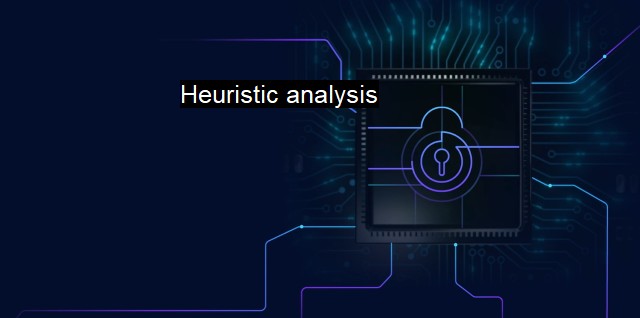What are Heuristic analysis?
Heuristic Analysis: Developing Early Detection and Predictive Threat Prevention for Cybersecurity
Heuristic analysis is a key component within cybersecurity and antivirus protocols designed for the purpose of detecting and combating significantly disruptive threats such as malware. This manner of identification detects novel viruses or variants of currently known viruses going beyond traditional methods. It provides security software with essential advance understanding capable of identifying abnormal or dangerous activities that could harm a device.The term "heuristic" is derived from the Greek word heuriskein which refers to "to find" or "to discover". In computer science, the term is used to explain various methods which optimize a rapid diagnosis or discovery when an optimal solution can be delayed. This strategy is apt for virus detection as unknown, yet potentially harmful, activities can be immediately recognized and addressed.
Among the different tactics, matrix, rule-based, genetic, sandbox, and statistical are five prominent methods of heuristic analyses used to safeguard systems against malware.
Matrix heuristics compare different attributes contained in a program with similar elements from a pre-existing database of identified malware. A program with an extensive number of replicated characteristics from known viruses classifies as a potential threat.
Meanwhile, in rule-based heuristics, experts create specific guidelines based on their prior knowledge and expertise. An antivirus program searches for suspicious activities within a system by following these selected criteria.
In genetic heuristic analysis, the program focuses on identifying pattern anomalies instead of individual patterns themselves. They imitate human intelligence to rectify minor mutations accurately within the genetic code that might become a part of harmful malware.
A rather dynamic approach is taken by sandbox heuristic analysis which launches the received file within an emulated and secluded environment. This kind of an examination reviews the performance of a program without causing danger to the actual device.
Statistical heuristic analysis, the last mentioned strategy using trainable algorithms, randomly dissects software applications. It presents accurate results since it inquires programs based on different permutations and combinations utilising machine learning.
Heuristic analysis is not free of flaws. Owing to its predictive nature, it can sometimes result in false positives where harmless applications are mistakenly identified as threats. Confidential files can get deleted, and reliable softwares can get blocked, disrupting the usual workflow.
Various new malware evolves constantly with sophisticated techniques that can bypass heuristics. The sandbox method falls weak against threats armed with anti-sandbox techniques as they remain passive during the analysis and become active once they enter the real system environment.
In spite of the existing flaws, heuristic analysis plays a vital role in cybersecurity. It enables a proactive approach to defend against unknown threats and malware. While old databases become inadequate in providing the necessary defense, heuristic analysis anticipates possible incoming threats defending the system against future infringements.
It's important to mention that even though heuristic analyses can command considerable computing resources and slow down system performances, it is an indispensable ally in the continuous fight against cyber threats. Efficient trade-offs between system performance and robust security parameters must be evaluated and implemented on a case-to-case basis.
Heuristic analysis has substantially transformed and enhanced modern antivirus detection and response strategies. With new threats unearthed every day, the heuristic approach designed to detect unusual behaviour patterns is often the solution to exposing unknown risks before they can inflict damage. Even with its limitations, heuristic analysis offers a unique line of defense in a constantly evolving digital landscape, making it a crucial aspect of cybersecurity.

Heuristic analysis FAQs
What is heuristic analysis in cybersecurity and antivirus?
Heuristic analysis is a method of identifying viruses and other malicious software that have not been previously identified. It involves analyzing the code and behavior of potentially harmful software to determine if it exhibits characteristics that suggest it is a threat.How does heuristic analysis differ from signature-based detection?
Signature-based detection involves identifying viruses based on their unique code, whereas heuristic analysis relies on identifying patterns of behavior that may indicate the presence of malware. While signature-based detection is effective at identifying known threats, heuristic analysis is necessary for detecting new and evolving threats that may not yet be recognized through traditional methods.What are some limitations of heuristic analysis in cybersecurity?
One limitation of heuristic analysis is the possibility of false positives, where legitimate software or behavior is incorrectly identified as a threat. Another limitation is the potential for evasion by sophisticated malware that is designed to avoid detection by heuristic analysis.How can heuristic analysis be used to enhance cybersecurity?
Heuristic analysis can be used to supplement traditional methods of threat detection and to provide an additional layer of security against new and evolving threats. When combined with other techniques such as signature-based detection and machine learning algorithms, heuristic analysis can help organizations stay ahead of cyber threats and protect their systems and data.| | A | | | B | | | C | | | D | | | E | | | F | | | G | | | H | | | I | | | J | | | K | | | L | | | M | |
| | N | | | O | | | P | | | Q | | | R | | | S | | | T | | | U | | | V | | | W | | | X | | | Y | | | Z | |
| | 1 | | | 2 | | | 3 | | | 4 | | | 7 | | | 8 | | |||||||